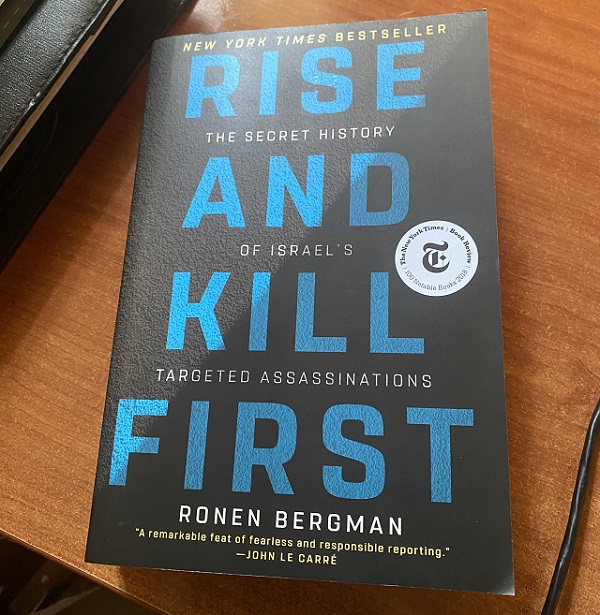
From the establishment of the State in 1948 to present day
Kampala, Uganda | IAN KATUSIIME | Reading Ronen Bergman’s Rise and Kill First: The Secret History of Israel’s Targeted Assassinations may require one to suspend any moral and ethical concerns to understand how the state of Israel evolved into the theatre of Great Power Politics.
Bergman is an Israeli investigative journalist who has built a career covering security and intelligence and amassed a large network of sources in Israel’s defence and security establishment.
After he was approached by Penguin Random House to write a book on the subject, Bergman spent eight years on the project to produce a 700-page tome where he convinced political leaders, chiefs and operatives of one of the most impenetrable intelligence communities to sit down for interviews and hand over highly sensitive documents. The book was published in 2018 but as early as 2010, the Israeli government had made plans to thwart its publication.
Bergman traces the journey from statehood in 1948 when founding prime minister Ben-Gurion created the AMAN (military intelligence), Shin Bet (internal security), and the Mossad ( the clandestine agency for operations beyond Israel’s borders) to work alongside the Israel Defence Forces (IDF) to defend the country against its mortal enemies.
Rise and Kill First is an original spy thriller written from an Israeli perspective with not too subtle justifications for why some operations had to be conducted to protect the state of Israel against what the author routinely calls “Palestine terrorists.”
The book credits Meir Dagan, who joined the IDF as a teen, as the man who synthesised the “targeted killings” doctrine that turned Israel into a force to be reckoned with worldwide. He went on to become arguably the most successful Mossad director.
He writes “The guiding principle of the doctrine was that Israel should avoid large wars, because the “great speedy victory of the Six-Day War will never happen again.”
There are details of operations such as “Spring of Youth” (in Lebanon), “Introductory Lesson” (killing Abu Jihad), “Salt Fish” (killing Yasser Arafat), “Picking Anemones” (against political leaders) and the weighty considerations made by Israeli Prime Ministers before they signed the “Red Page” (authorisation for the hit).
The Entebbe Airport raid where 100 Israeli hostages were rescued in 1976 is mentioned for how it became a model for how to handle hostage situations. “No negotiation and no compromise with terrorists, but a steadfast willingness to go to extraordinary lengths and even to risk lives in order to free hostages.”
The book takes readers on a journey inside the lives of the most renowned figures in Israeli history such as Ehud Barak, Ariel Sharon, Yitzhak Rabin, Benjamin Netanyahu who all served in the military and rose to become Prime Minister. Golda Meir who is Israel’s only female prime minister is also portrayed as firm and aggressive. He explains their decision making process, personal quirks, and what their philosophy of protecting their country was like.
Ariel Sharon features prominently in the book and while as defence minister in the 1980s, he displayed a maniacal obsession with killing Arafat, the leader of the Palestine Liberation Organisation (PLO).
Sharon wanted Arafat, a respected political figure internationally, dead at all costs even giving orders to blow up passenger planes if that was the price of eliminating the Palestine leader. Ultimately, he was several times defied by his subordinates who felt the action was not worth the risk.
In the book, Bergman documents how many in the Israeli decision making hierarchy wrestled with moral questions when planning a hit on a target in the vicinity of their family, children or innocent civilians. He also illustrates in great detail how agents studied targets; their routine, entrapped them and finally took them out.
The book brings great insights in the unending war between Israel and Palestine and how the two relentlessly seek ways to annihilate each other although, as the book shows, it is an asymmetric conflict where Palestine’s lone wolf attacks are no match for Israel’s firepower much as there are innumerable causalities on both sides.
Israeli elite units like Sayeret Matkal, Flotilla 13, Caesarea face off against operatives of Hamas, Fatah and any Palestinian who is willing to be a shahid (Arabic for martyr).
Bergman captures the intrigue and mutual suspicion around the Israel-Palestine peace talks happening while Israeli agents had bugged the office of Arafat’s deputy in the PLO.
In 1993, an Israeli on the negotiating team in Oslo where the talks were happening got suspicious of the intelligence briefings they were receiving and tipped off his Palestine counterparts. “In other words, an Israeli diplomat betrayed Israeli intelligence to prevent Israeli intelligence from sabotaging Israeli diplomacy.”
Rise and Kill First is a meticulously well-researched book that brilliantly chronicles events in Israel, the Middle East and the interplay of powerful countries like the U.S, U.K. France and the Soviet Union.
In the 1990s the world had become strongly critical of the targeted killings program by Israel as a defence mechanism against Palestine. But there was an about turn after 9/11 when Al Qaeda terrorists crashed planes into the World Trade Centre sparking a U.S.-led Global War on Terror. The U.S. and others went from being critics to consulting Israel on the very same protocols.
The book is an endlessly riveting and harrowing portrait of a mythical intelligence community by an intrepid investigative reporter. Bergman pulled off what could be the single most successful journalistic coup of the past decade.
 The Independent Uganda: You get the Truth we Pay the Price
The Independent Uganda: You get the Truth we Pay the Price


